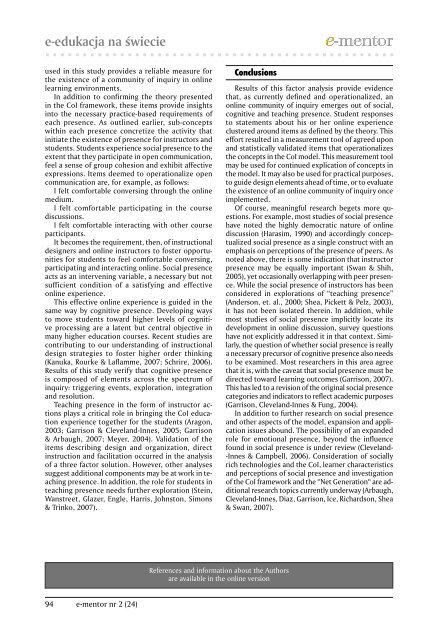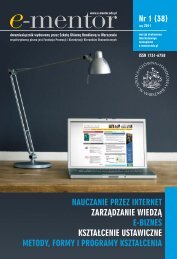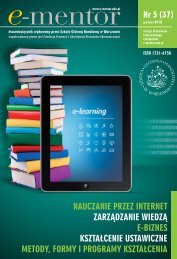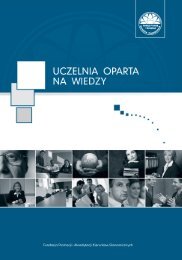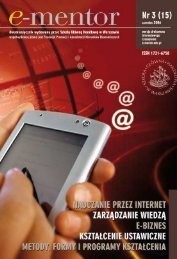Ocena zachowania użytkowników platformy handlu C2C - E-mentor
Ocena zachowania użytkowników platformy handlu C2C - E-mentor
Ocena zachowania użytkowników platformy handlu C2C - E-mentor
You also want an ePaper? Increase the reach of your titles
YUMPU automatically turns print PDFs into web optimized ePapers that Google loves.
e-edukacja na świecieused in this study provides a reliable measure forthe existence of a community of inquiry in onlinelearning environments.In addition to confirming the theory presentedin the CoI framework, these items provide insightsinto the necessary practice-based requirements ofeach presence. As outlined earlier, sub-conceptswithin each presence concretize the activity thatinitiate the existence of presence for instructors andstudents. Students experience social presence to theextent that they participate in open communication,feel a sense of group cohesion and exhibit affectiveexpressions. Items deemed to operationalize opencommunication are, for example, as follows:I felt comfortable conversing through the onlinemedium.I felt comfortable participating in the coursediscussions.I felt comfortable interacting with other courseparticipants.It becomes the requirement, then, of instructionaldesigners and online instructors to foster opportunitiesfor students to feel comfortable conversing,participating and interacting online. Social presenceacts as an intervening variable, a necessary but notsufficient condition of a satisfying and effectiveonline experience.This effective online experience is guided in thesame way by cognitive presence. Developing waysto move students toward higher levels of cognitiveprocessing are a latent but central objective inmany higher education courses. Recent studies arecontributing to our understanding of instructionaldesign strategies to foster higher order thinking(Kanuka, Rourke & Laflamme, 2007; Schrire, 2006).Results of this study verify that cognitive presenceis composed of elements across the spectrum ofinquiry: triggering events, exploration, integrationand resolution.Teaching presence in the form of instructor actionsplays a critical role in bringing the CoI educationexperience together for the students (Aragon,2003; Garrison & Cleveland-Innes, 2005; Garrison& Arbaugh, 2007; Meyer, 2004). Validation of theitems describing design and organization, directinstruction and facilitation occurred in the analysisof a three factor solution. However, other analysessuggest additional components may be at work in teachingpresence. In addition, the role for students inteaching presence needs further exploration (Stein,Wanstreet, Glazer, Engle, Harris, Johnston, Simons& Trinko, 2007).ConclusionsResults of this factor analysis provide evidencethat, as currently defined and operationalized, anonline community of inquiry emerges out of social,cognitive and teaching presence. Student responsesto statements about his or her online experienceclustered around items as defined by the theory. Thiseffort resulted in a measurement tool of agreed uponand statistically validated items that operationalizesthe concepts in the CoI model. This measurement toolmay be used for continued explication of concepts inthe model. It may also be used for practical purposes,to guide design elements ahead of time, or to evaluatethe existence of an online community of inquiry onceimplemented.Of course, meaningful research begets more questions.For example, most studies of social presencehave noted the highly democratic nature of onlinediscussion (Harasim, 1990) and accordingly conceptualizedsocial presence as a single construct with anemphasis on perceptions of the presence of peers. Asnoted above, there is some indication that instructorpresence may be equally important (Swan & Shih,2005), yet occasionally overlapping with peer presence.While the social presence of instructors has beenconsidered in explorations of “teaching presence”(Anderson, et. al., 2000; Shea, Pickett & Pelz, 2003),it has not been isolated therein. In addition, whilemost studies of social presence implicitly locate itsdevelopment in online discussion, survey questionshave not explicitly addressed it in that context. Similarly,the question of whether social presence is reallya necessary precursor of cognitive presence also needsto be examined. Most researchers in this area agreethat it is, with the caveat that social presence must bedirected toward learning outcomes (Garrison, 2007).This has led to a revision of the original social presencecategories and indicators to reflect academic purposes(Garrison, Cleveland-Innes & Fung, 2004).In addition to further research on social presenceand other aspects of the model, expansion and applicationissues abound. The possibility of an expandedrole for emotional presence, beyond the influencefound in social presence is under review (Cleveland--Innes & Campbell, 2006). Consideration of sociallyrich technologies and the CoI, learner characteristicsand perceptions of social presence and investigationof the CoI framework and the “Net Generation“ are additionalresearch topics currently underway (Arbaugh,Cleveland-Innes, Diaz, Garrison, Ice, Richardson, Shea& Swan, 2007).References and information about the Authorsare available in the online version94 e-<strong>mentor</strong> nr 2 (24)


